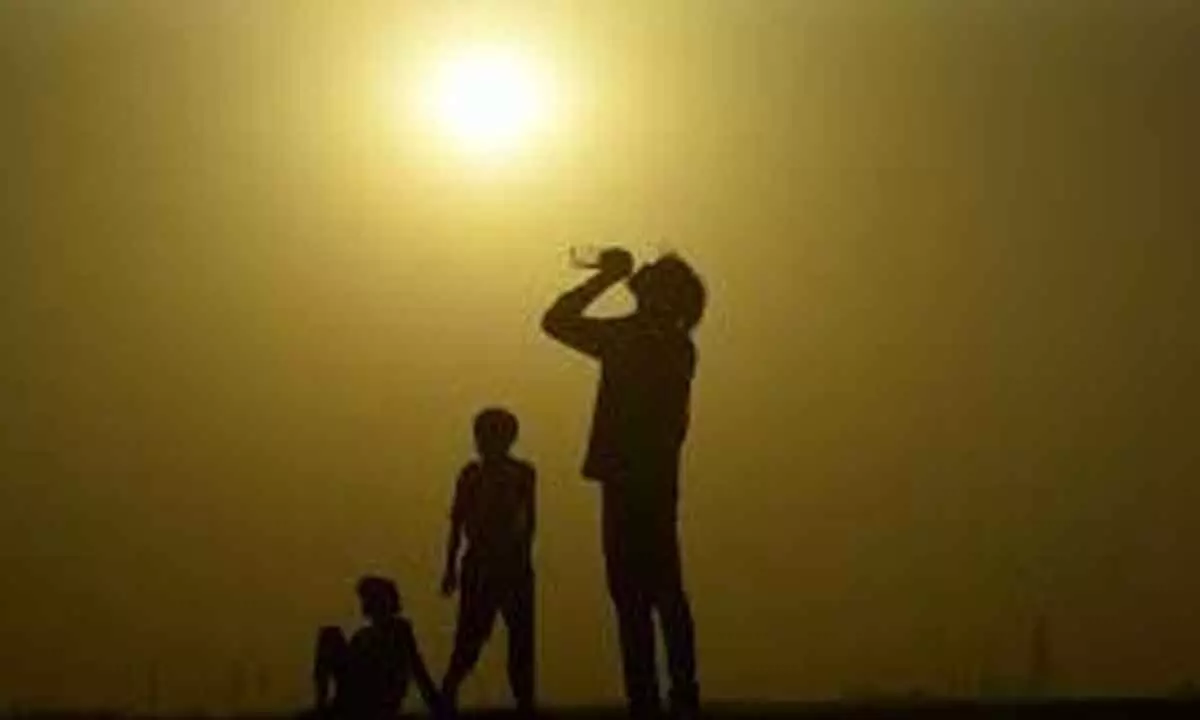Live
- Over 7,600 Syrians return from Turkiye in five days after Assad's downfall: minister
- Delhi BJP leaders stay overnight in 1,194 slum clusters
- Keerthy Suresh and Anthony Thattil Tie the Knot in a Christian Ceremony
- AAP, BJP making false promises to slum dwellers for votes: Delhi Congress
- 'Vere Level Office' Review: A Refreshing Take on Corporate Life with Humor and Heart
- Libya's oil company declares force majeure at key refinery following clashes
- Illegal Rohingyas: BJP seeks Assembly session to implement NRC in Delhi
- Philippines orders full evacuation amid possible volcanic re-eruption
- Government Prioritizes Welfare of the Poor, says Dola Sri Bala Veeranjaneyaswamy
- Two Russian oil tankers with 29 on board damaged due to bad weather
Just In
India to see 'significantly' more heatwave days till June


New Delhi: Most of India, barring parts of northwest and peninsular region, is expected to experience above-normal maximum temperatures from April to...
New Delhi: Most of India, barring parts of northwest and peninsular region, is expected to experience above-normal maximum temperatures from April to June, the India Meteorological Department (IMD) said on Saturday. It said above-normal heatwave days are predicted in most parts of central, east and northwest India during this period.
"During the 2023 hot weather season (April to June), most parts of the country are expected to experience above-normal maximum temperatures, except for south peninsular India and some parts of northwest India where normal to below-normal maximum temperatures are likely," the IMD said.
"A significantly higher number of heatwave days are predicted over parts of Bihar, Jharkhand, Uttar Pradesh, Odisha, West Bengal, Chhattisgarh, Maharashtra, Gujarat, Punjab and Haryana," IMD Director General Mrutyunjay Mahapatra said in a virtual press conference.
India logged its hottest February this year since record-keeping began in 1901, according to the IMD. However, above-normal rainfall (37.6 mm against a normal of 29.9 mm) due to seven western disturbances, including five strong ones, kept temperatures in check in March. March 2022 was the warmest ever and the third driest in 121 years. The year also saw the country's third-warmest April, eleventh-warmest August and eighth-warmest September since 1901.
The IMD said normal to above-normal minimum temperatures are very likely over most parts of the country, barring some areas in northeast and northwest India and isolated pockets of the peninsular region. Last month, the Centre For Policy Research (CPR) said a review of 37 heat action plans in India shows most of them do not explicitly carry out vulnerability assessments, leaving the authorities with little data on where to direct their scarce resources. Heat action plans (HAPs) are the primary policy response to economically damaging and life-threatening heatwaves.
They prescribe a number of activities, disaster responses and post-heatwave response measures to reduce the impact of heatwaves. The weather bureau said India is expected to see normal rainfall in April.
Based on data collected from 1971 to 2020, the country on an average receives 39.2 mm of rainfall in April.
Normal to above-normal precipitation is expected over most parts of northwest, central and peninsular region, while below-normal rain is predicted in east and northeast India. La Nina conditions, cooling of the waters in the Pacific Ocean near South America that favours the Indian monsoon, have weakened, according to the IMD.
"Forecast indicates ENSO neutral conditions are likely from April to June. A transition to El Niño is favoured by July-September, with chances of El Niño increasing through the fall," Mahapatra said.
El Niño, the warming of the waters in the Pacific Ocean near South America, is associated with the weakening of monsoon winds and less rainfall in India. However, the Met office said that several models indicate the development of a positive Indian Ocean Dipole (IOD) in the coming months.
The Bureau of Meteorology model also indicates the development of positive IOD by May 2023.
IOD is defined by the difference in the sea surface temperatures between the western part of the Indian Ocean near Africa and the eastern part of the Indian Ocean near Indonesia. A positive IOD is considered good for the Indian monsoon. The monsoon accounts for around 70 per cent of the country's annual rainfall and irrigates 60 per cent of its net sown area.
Nearly half of the population depends on agriculture directly or indirectly. The weatherman said at least 100 weather stations across the country reported heavy rain events (64.5 mm to 115.5 mm), the highest since 2018.
The prolonged spell of pre-monsoon rain, thunderstorms, hailstorms and lightning strikes damaged crops in many parts of Uttar Pradesh, Haryana, Punjab, Rajasthan, Madhya Pradesh, Maharashtra and other states.
The mango crop in the country has been damaged up to 20 per cent because of the untimely rains, hailstorm and strong wind, according to senior officials at the Indian Council for Agricultural Research.

© 2024 Hyderabad Media House Limited/The Hans India. All rights reserved. Powered by hocalwire.com






